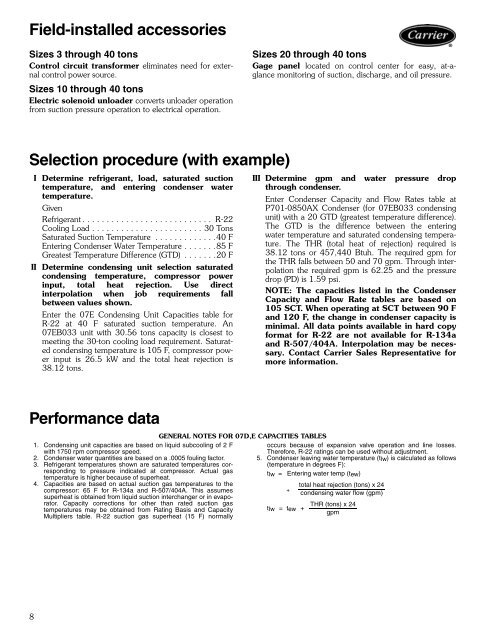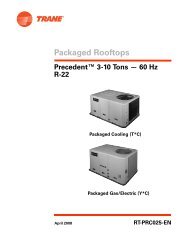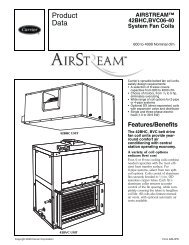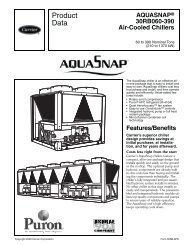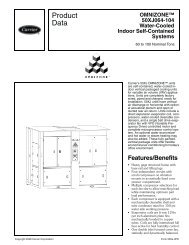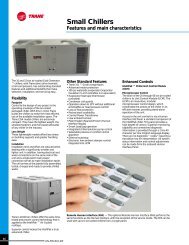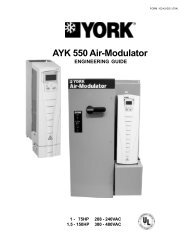Product Data
Product Data
Product Data
Create successful ePaper yourself
Turn your PDF publications into a flip-book with our unique Google optimized e-Paper software.
Field-installed accessories<br />
Sizes 3 through 40 tons<br />
Control circuit transformer eliminates need for external<br />
control power source.<br />
Sizes 10 through 40 tons<br />
Electric solenoid unloader converts unloader operation<br />
from suction pressure operation to electrical operation.<br />
Selection procedure (with example)<br />
I Determine refrigerant, load, saturated suction<br />
temperature, and entering condenser water<br />
temperature.<br />
Given<br />
Refrigerant . . . . . . . . . . . . . . . . . . . . . . . . . . . R-22<br />
Cooling Load . . . . . . . . . . . . . . . . . . . . . . . 30 Tons<br />
Saturated Suction Temperature . . . . . . . . . . . . .40 F<br />
Entering Condenser Water Temperature . . . . . . .85 F<br />
Greatest Temperature Difference (GTD) . . . . . . .20 F<br />
II Determine condensing unit selection saturated<br />
condensing temperature, compressor power<br />
input, total heat rejection. Use direct<br />
interpolation when job requirements fall<br />
between values shown.<br />
Enter the 07E Condensing Unit Capacities table for<br />
R-22 at 40 F saturated suction temperature. An<br />
07EB033 unit with 30.56 tons capacity is closest to<br />
meeting the 30-ton cooling load requirement. Saturated<br />
condensing temperature is 105 F, compressor power<br />
input is 26.5 kW and the total heat rejection is<br />
38.12 tons.<br />
Performance data GENERAL NOTES FOR 07D,E CAPACITIES TABLES<br />
8<br />
1. Condensing unit capacities are based on liquid subcooling of 2 F<br />
with 1750 rpm compressor speed.<br />
2. Condenser water quantities are based on a .0005 fouling factor.<br />
3. Refrigerant temperatures shown are saturated temperatures corresponding<br />
to pressure indicated at compressor. Actual gas<br />
temperature is higher because of superheat.<br />
4. Capacities are based on actual suction gas temperatures to the<br />
compressor: 65 F for R-134a and R-507/404A. This assumes<br />
superheat is obtained from liquid suction interchanger or in evaporator.<br />
Capacity corrections for other than rated suction gas<br />
temperatures may be obtained from Rating Basis and Capacity<br />
Multipliers table. R-22 suction gas superheat (15 F) normally<br />
Sizes 20 through 40 tons<br />
Gage panel located on control center for easy, at-aglance<br />
monitoring of suction, discharge, and oil pressure.<br />
III Determine gpm and water pressure drop<br />
through condenser.<br />
Enter Condenser Capacity and Flow Rates table at<br />
P701-0850AX Condenser (for 07EB033 condensing<br />
unit) with a 20 GTD (greatest temperature difference).<br />
The GTD is the difference between the entering<br />
water temperature and saturated condensing temperature.<br />
The THR (total heat of rejection) required is<br />
38.12 tons or 457,440 Btuh. The required gpm for<br />
the THR falls between 50 and 70 gpm. Through interpolation<br />
the required gpm is 62.25 and the pressure<br />
drop (PD) is 1.59 psi.<br />
NOTE: The capacities listed in the Condenser<br />
Capacity and Flow Rate tables are based on<br />
105 SCT. When operating at SCT between 90 F<br />
and 120 F, the change in condenser capacity is<br />
minimal. All data points available in hard copy<br />
format for R-22 are not available for R-134a<br />
and R-507/404A. Interpolation may be necessary.<br />
Contact Carrier Sales Representative for<br />
more information.<br />
occurs because of expansion valve operation and line losses.<br />
Therefore, R-22 ratings can be used without adjustment.<br />
5. Condenser leaving water temperature (tlw) is calculated as follows<br />
(temperature in degrees F):<br />
tlw = Entering water temp (tew)<br />
total heat rejection (tons) x 24<br />
+<br />
condensing water flow (gpm)<br />
tlw = tew +<br />
THR (tons) x 24<br />
gpm


